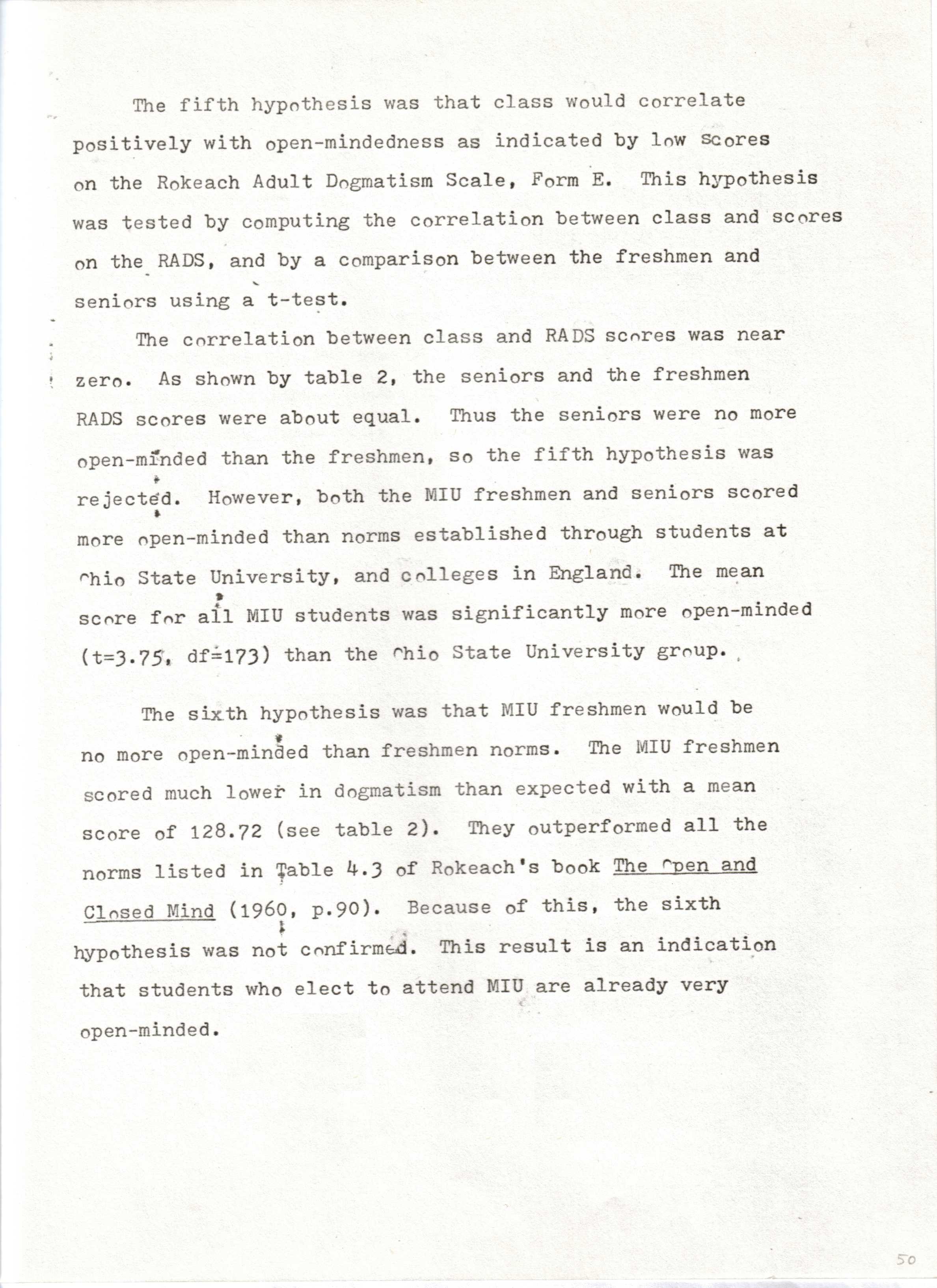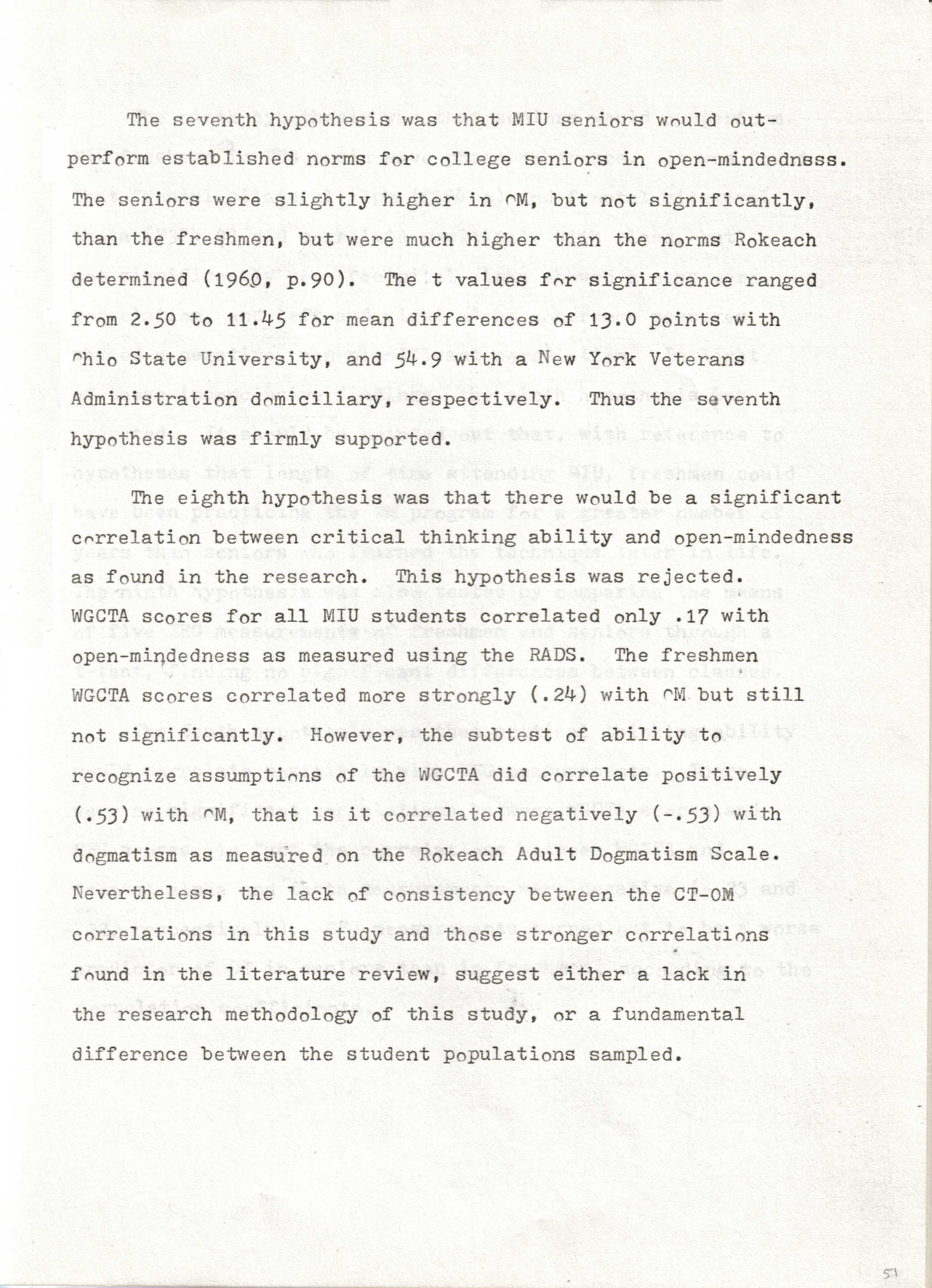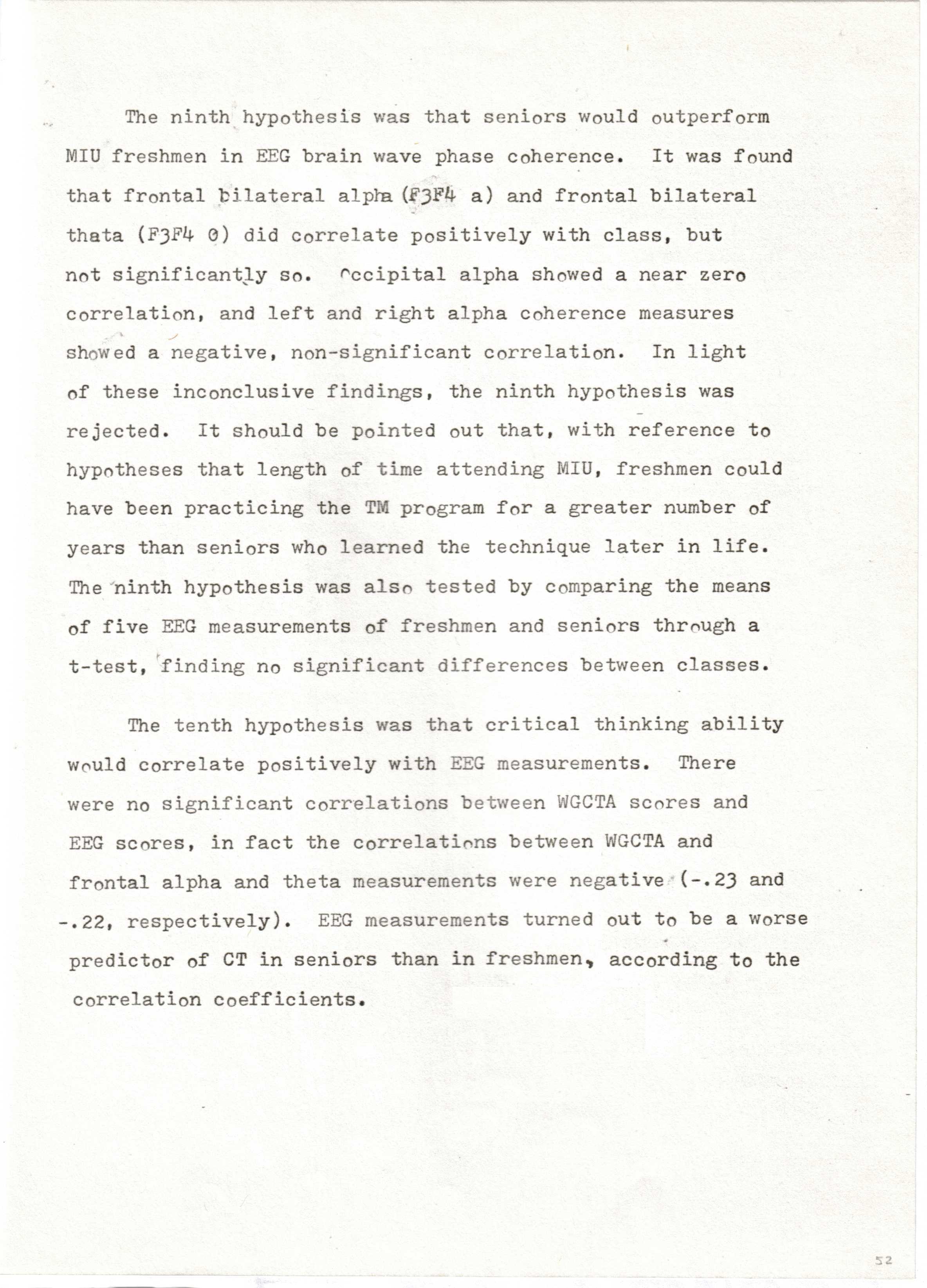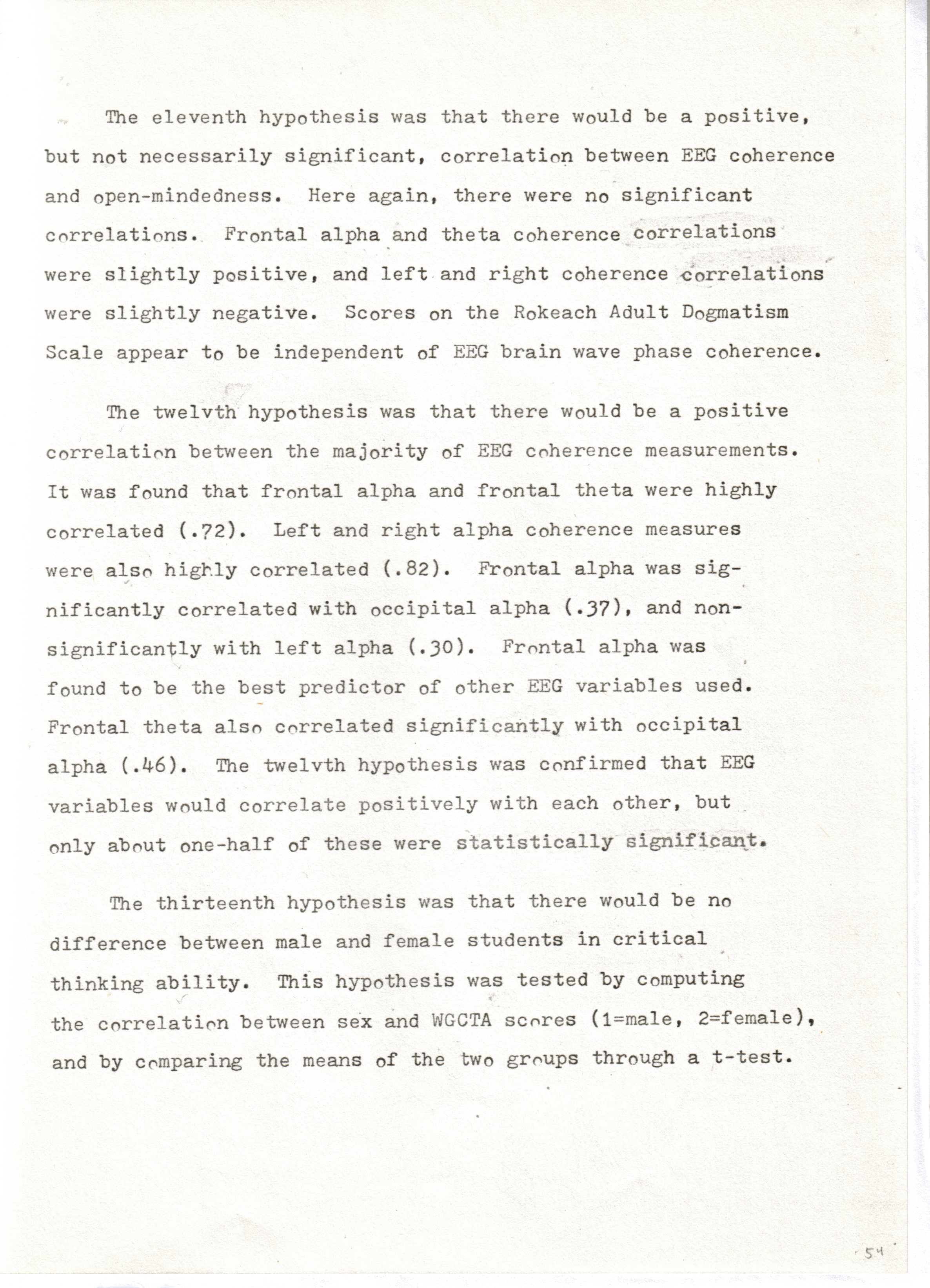
ctomeegmiu50.jpg
|
The fifth hypothesis was that class would
correlate
positively with open-mindedness as
indicated by low Scores
on the Rokeach Adult Dogmatism Scale, Form
E. This hypothesis
was tested by computing the correlation
between class and scores
on the RADS, and by a comparison between
the freshmen and
seniors using a t-test.
The correlation between class and RADS
scores was near
zero. As shown by table 2, the seniors and
the freshmen
RADS scores were about equal. Thus the
seniors were no more
open-minded than the freshmen, so the fifth
hypothesis was
rejected. However, both the MIU freshmen
and seniors scored
more open-minded than norms established
through students at Ohio State University, and colleges in
England. The mean
score for all MIU students was
significantly more open-minded
(t=3.75, df=173} than the Ohio State University group.
The sixth hypothesis was that MIU freshmen
would be no more open-minded than freshmen norms.
The MIU freshmen
scored much lower in dogmatism than
expected with a mean
score of 128.72 (see table 2). They
outperformed all the norms listed in Table 4.3 of Rokeach's
book The Open and Closed Mind (1960, p.90). Because of
this, the sixth
hypothesis was not confirmed. This result
is an indication
that students who elect to attend MIU are
already very
open-minded.
|

ctomeegmiu51.jpg
|
The seventh hypothesis was that MIU seniors
would out-perform established norms for college
seniors in open-mindedness.
The seniors were slightly higher in OM, but
not significantly,
than the freshmen, but were much higher
than the norms Rokeach
determined (1960, p.90). The t values for
significance ranged
from 2.50 to 11.45 for mean differences of
13.0 points with Ohio State University, and 54.9 with a New
York Veterans
Administration domiciliary, respectively.
Thus the seventh
hypothesis was firmly supported.
The eighth hypothesis was that there would
be-a significant
correlation between critical thinking
ability and open-mindedness
as found in the research. This hypothesis
was rejected.
WGCTA scores for all MIU students
correlated only .17 with
open-mindedness as measured using the RADS.
The freshmen
WGCTA scores correlated more strongly (.24)
with OM but still
not significantly.
However, the subtest of
ability to
recognize assumptions of the WGCTA did
correlate positively
(.53) with OM, that is it correlated
negatively (-.53) with
dogmatism as measured on the Rokeach Adult
Dogmatism Scale.
Nevertheless, the lack of consistency
between the CT-OM
correlations in this study and those
stronger correlations
found in the literature review, suggest
either a lack in
the research methodology of this study, or
a fundamental
difference between the student populations
sampled.
|

ctomeegmiu52.jpg
|
The ninth hypothesis was that seniors would
outperform
MIU freshmen in EEG brain wave phase
coherence. It was found
that frontal bilateral alph1(F3F4 a) and
frontal bilateral
theta (F3F4 Ø) did correlate positively
with class, but
not significantly so. Occipital alpha
showed a near zero
correlation, and left and right alpha
coherence measures
showed a negative, non-significant
correlation.
In light
of these inconclusive findings, the ninth
hypothesis was
rejected. It should be pointed out that,
with reference to
hypotheses that length of time attending
MIU, freshmen could
have been practicing the TM program for a
greater number of
years than seniors who learned the
technique later in life.
The ninth hypothesis was also tested by
comparing the means
of five EEG measurements of freshmen and
seniors through a
t-test, finding no significant differences
between classes.
The tenth hypothesis was that critical
thinking ability
would correlate positively with EEG
measurements. There
were no significant correlations between
WGCTA scores and
EEG scores, in fact the correlations
between WGCTA and
frontal alpha and theta measurements were
negative (-.23 and
-.22, respectively). EEG measurements
turned out to be a worse
predictor of CT in seniors than in
freshmen, according to the
correlation coefficients. |

ctomeegmiu54.jpg
|
The eleventh hypothesis was that there would be a
positive,
but not necessarily significant,
correlation between EEG coherence
and open-mindedness. Here again, there were
no significant
correlations. Frontal alpha and theta
coherence correlations
were slightly positive, and left and right
coherence correlations
were slightly negative. Scores on the
Rokeach Adult Dogmatism
Scale appear to be independent of EEG brain
wave phase coherence.
The twelfth hypothesis was that there would
be a positive
correlation between the majority of EEG
coherence measurements.
It was found that frontal alpha and frontal
theta were highly
correlated (.72). Left and right alpha
coherence measures
were also highly correlated (.82). Frontal
alpha was significantly correlated with occipital alpha
(.37). and non-significantly with left alpha (.30).
Frontal alpha was
found to be the best predictor of other EEG
variables used.
Frontal theta also correlated significantly
with occipital
alpha (.46). The twelfth hypothesis was confirmed that EEG
variables would correlate positively with each other, but
only about one-half of these were
statistically significant.
The thirteenth hypothesis was that there
would be no
difference between male and female students
in critical.
thinking ability. This hypothesis was
tested by computing
the correlation between sex and WGCTA
scores (1=male, 2=female)
and by comparing the means of the two groups through a t-test.
|